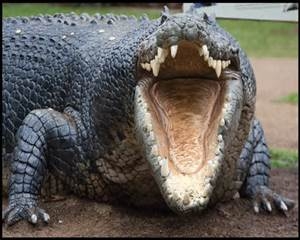
She believed it to be a gopher, so we discussed the typical signs of gopher activity. The telltale sign is a surfacemound of dirt in a crescent shape.
Gophers use their large forefeet and claws to dig extensive underground tunnels. They primarily feed on roots, but they will venture a short distance out of their tunnels to feed on vegetation above ground. If you've seen the film Caddyshack, you know that they often pull their food down into their tunnels. They have large cheeks that they fill with food.
Excluding them from raised beds is the best way to discourage these voracious herbivores. Lining the bottom of your beds with hardware cloth (metal sheets with small holes) will prevent them from entering your raised beds. This approach also foils other vertebrate pests such as moles, voles and rats. Trapping also works.
You can find more information on trapping vertebrate pest at http://www.ipm.ucdavis.edu/PMG/PESTNOTES/. This site has excellent research-based information on all things related to garden pests.
The mounds in my friend's raised beds were not crescent-shaped, so we talked about some of the other usual suspects: moles, voles and rats.
Moles make volcano-like mounds. They are carnivorous, eating grubs and insects that you typically don't want in your lawn. It's the damage from their shallow five- to eight-inch-deep burrows that makes them a pest.
Trapping works best with moles. You will need to set at least two traps together, each facing outward, to catch the pest going either direction in the tunnel. Gopher trapping is usually successful within a day or two, but moles require more patience. They can take up to a week to trap.
My friend's loss of plants in her raised beds meant her problem was not likely a mole. This left us with my nemesis: voles.
Voles are small, mouse-sized critters, typically five to eight inches long, including their tails. They are equally happy above and below ground, but they prefer not to feed in open areas. They store their food below groundwhere they are protected from predators and can rest before they continue with their destruction of your garden. They locate their tunnels in areas of protective grasses. Exposing and removing their burrow holes is one way to manage them.
Voles are herbivores, eating an assortment of roots, seeds and above ground plant matter. They operate day and night. If you spot trees with chewed areas a few inches above the ground, you may have voles. This girdling can kill trees, especially young trees. Maintain a three- to four-foot barrier of soil without mulch or weeds to discourage voles from feeding on your trees. Use small-gauge wire fencing with less than ¼-inch openings to keep them out of areas. Bury the fence six to ten inches and make sure it is at least twelve inches above ground.
Mousetraps can be effective with voles. Look for their burrows or above ground runways in grasses. Set the trap at a 90-degree angle to the runway or burrow with the trap end in the pathway.
As a barefooted youngster, I remember when my dad hit a mouse nest while digging for potatoes in our garden. I have had an irrational fear of these critters since. I can still hear their screams.
Rats and mice are similar except for size. Rats are nocturnal, and they cause us extra concern because they can carry diseases. If you keep your pet's water or feeding dishes outside, look for signs of rodent droppings nearby. Wood stacks are the perfect habitat for mice and rats. Monitor for rodent nests. Rats will also burrow, but their exit hole is not usually marked by a soil mound. They like to run along walls, so look there for smudge spots that indicate their activity.
To control them, keep things clean, orderly and off the ground. Remove nests as you find them. Contain garbage with tight-fitting lids. Remove access to food and standing water. Seal cracks. Rats can fit in holes the size of a quarter, and mice can fit into much smaller holes.
There are many different types of traps for mice and rats. Personally, once I caught a mouse, both the creature and the snap trap were removed. No recycling. New electronic traps are more humane and have lights to indicate a creature has used the trap. The trapped pest can be handled without touching it by simply picking up the trap and disposing of the animal.
You can also combat these vertebrate pests with toxic baits. Thoroughly read and follow label instructions. We use surface water for drinking in most of Napa County so make sure you won't affect local waterways by using toxic materials. Also make sure your pet can't access the bait, or get the pest after it has eaten the bait. Use toxic materials only as a last resort, when other methods no longer do the job.
Workshop: Napa County Master Gardeners will conduct a workshop on “Vertebrate Critters in the Garden” on Saturday, 9:30 a.m. to 11:30 a.m., at University of California Cooperative Extension, 1710 Soscol Avenue, Napa. Are birds, raccoons, squirrels, rats or mice persistent pests in your garden? Moles and gophers making holes all over? This workshop helps home gardeners identify and understand the behavior of vertebrate pests and assess control options.Online registration (credit card only)Mail-in registration (cash or check only)
Master Gardeners are volunteers who help the University of California reach the gardening public with home gardening information. Napa County Master Gardeners ( http://ucanr.org/ucmgnapa/) are available to answer gardening questions in person or by phone, Monday, Wednesday and Friday, 9 a.m. to Noon, at the U. C. Cooperative Extension office, 1710 Soscol Avenue, Suite 4, Napa, 707-253-4143, or from outside City of Napa toll-free at 877-279-3065. Or e-mail your garden questions by following the guidelines on our web site. Click on Napa, then on Have Garden Questions? Find us on Facebook under UC Master Gardeners of Napa County.